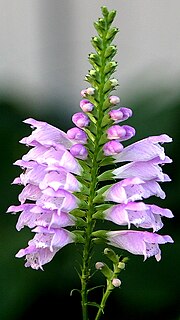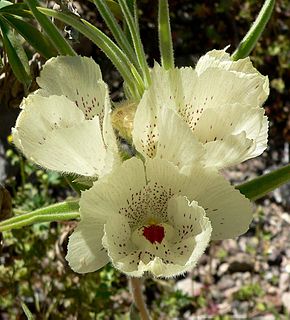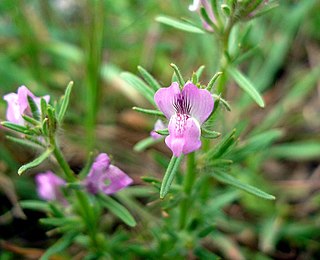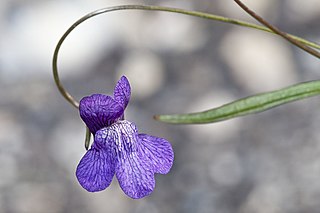
Antirrhinum is a genus of plants commonly known as dragon flowers, snapdragons and dog flower because of the flowers' fancied resemblance to the face of a dragon that opens and closes its mouth when laterally squeezed. They are native to rocky areas of Europe, the United States, Canada, and North Africa. It is widely used as an ornamental plant in borders and as a cut flower.
Toadflax is the common name of several related genera of plants in the family Plantaginaceae, including:

Thalictrum is a genus of 120-200 species of herbaceous perennial flowering plants in the buttercup family, Ranunculaceae, native mostly to temperate regions. Meadow-rue is a common name for plants in this genus.

The Lasiocampidae are a family of moths also known as eggars, snout moths, or lappet moths. Over 2,000 species occur worldwide, and probably not all have been named or studied.

A grison, , also known as a South American wolverine, is any mustelid in the genus Galictis. Native to Central and South America, the genus contains two extant species: the greater grison, which is found widely in South America, through Central America to southern Mexico; and the lesser grison, which is restricted to the southern half of South America.

Linaria vulgaris, the common toadflax, yellow toadflax or butter-and-eggs, is a species of flowering plant in the family Plantaginaceae, native to Europe, Siberia and Central Asia. It has also been introduced and is now common in North America.

Antirrhinum majus, the common snapdragon, is a species of flowering plant belonging to the genus Antirrhinum. The plant was placed in the family Plantaginaceae following a revision of its prior classical family, Scrophulariaceae.

Physostegia virginiana, the obedient plant, obedience or false dragonhead, is a species of flowering plant in the mint family, Lamiaceae. It is native to North America, where it is distributed from eastern Canada to northern Mexico. Physostegia are known commonly as obedient plants because a flower pushed to one side will often stay in that position. The name “false dragonhead” refers to the dragonheads of the related Dracocephalum, a genus to which the plant once belonged.

Mohavea is a plant genus consisting of two species native to the deserts of the southwestern United States and northern Mexico. This genus is often included in the closely related snapdragon genus Antirrhinum.

Zephyranthes candida, with common names that include autumn zephyrlily, white windflower, white rain lily, and Peruvian swamp lily, is a species of rain lily native to South America including Argentina, Uruguay, Paraguay, and Brazil. The species is widely cultivated as an ornamental and reportedly naturalized in many places.

Arctium minus, commonly known as lesser burdock, little burdock, louse-bur, common burdock, button-bur, cuckoo-button, or wild rhubarb, is a biennial plant. This plant is native to Europe, but has become introduced elsewhere such as Australia, North and South America, and other places.

Antirrhinum vexillo-calyculatum is a species of New World snapdragon found only in California and occasionally Oregon. This wildflower is known by several common names, including wiry snapdragon, sailflower snapdragon, and Brewer's snapdragon.

Misopates is a genus of the family Plantaginaceae, and is one of the groups of plants commonly known as 'snapdragons'. It has eight accepted species:

Antirrhinum kelloggii is a species of New World snapdragon known by the common name Kellogg's snapdragon.
Pseudorontium is a genus of flowering plants with one species, Pseudorontium cyathiferum, a New World snapdragon known by the common names dog's-mouth and Deep Canyon snapdragon. It is native to the deserts of northern Mexico and adjacent California and Arizona. It is an annual herb producing a hairy, erect, non-climbing stem with many oval-shaped leaves. The solitary flowers are dark-veined deep purple and white, often with some yellow in the throat, and are about a centimeter long. Previously considered to belong among the New World Antirrhinum species, it is now considered the sole member of the related genus Pseudorontium.
Antirrhinum virga is a species of New World snapdragon known by the common name tall snapdragon.

Stenoptilia bipunctidactyla, also known as the twin-spot plume is a moth of the Pterophoroidea family found in North Africa, Asia and Europe. It was first described by the Austrian physician and naturalist, Giovanni Antonio Scopoli in 1763. It is one of four similar looking moths.

Mohavea breviflora is a species of flowering plant in the plantain family known by the common names golden desert-snapdragon and lesser mohavea. It is native to the southwestern United States, including the Mojave Desert and surrounding areas.

Eriocaulon parkeri is a species of flowering plant in the pipewort family known by the common names Parker's pipewort and estuary pipewort. It is native to eastern North America, where its distribution spans the coast from Quebec to North Carolina. It is extirpated from New York and Pennsylvania, however.

Misopates calycinum is a species of annual herb in the family Plantaginaceae. They have simple leaves.
















